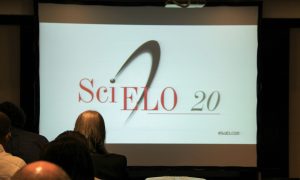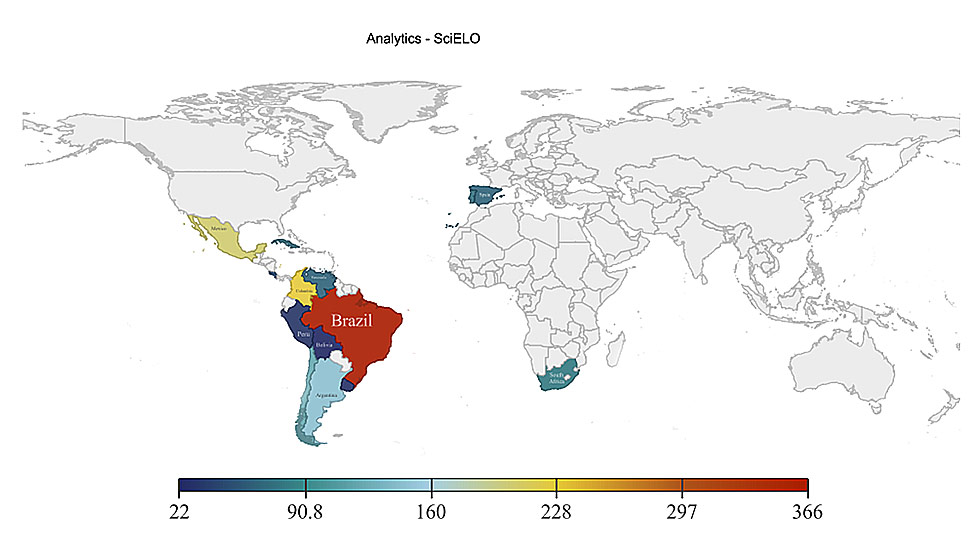By Peter Schulz
The SciELO 20-years Conference was held in September 2018, in which for three days “main political, methodological and technological issues that define today’s state of the art in scholarly communication and the trends and innovations that is shaping the future of the universal openness of scholarly publishing and its relationship with today’s Open Access journals” have been discussed1, with a major focus, clearly, on the SciELO network. This network (and platform) is probably known by the entire Brazilian scientific community as well as by society outside the academia walls. For those who do not know it, however, the acronym stands for Scientific Electronic Library Online. On its website stands the summary of the acronym meaning: “The Project envisages the development of a common methodology for the preparation, storage, dissemination and evaluation of scientific literature in electronic format.”2 The methodology has been developed, forming a platform for access to the scientific output. The project began in 1998 with only 10 scientific journals published in Brazil. Twenty years later there are 1,285 active journals from 14 countries. These numbers justify the visionary part of the title above in the sense of “it is said to be of an individual of grandiose ideas.” The adjective indispensable (“absolutely necessary; essential.”) is the motto of the rest of the text below.
The project is, therefore, pioneer in the production of an information source complementary to Web of Science (WoS) and Scopus, the international bibliographical (search for scientific references) and bibliometric (search for scientific output data) databases that “have been consolidated as reference sources of global bibliometric indicators and are used predominantly in scientific studies and reports and evaluation methodologies of scientific output”3. It is important to recall that the word evaluation has two meanings connected to the topic here: “determining the value of” and “understanding”, the latter being often forgotten, but it will be redeemed in this text. Both to determine value and to understand, it is necessary that the set of scientific output be well represented in the databases. SciELO represents precisely the fulfilling of important gaps in other databases with regard to Brazilian scientific output (and of the 13 other countries), notably in several areas of knowledge, such as Social Sciences, Humanities and Agrarian Sciences, Psychology / Psychiatry and Economics (see the article in note 3 and that of Dirce Santin and Sonia Caregnato4). International recognition on the importance to bridge these gaps can be inferred from the inclusion of the SciELO Citation Index to the WoS platforms.
In the search for indicators (more to evaluate than to understand), citations to articles published in articles which are part of this or that database occupy a prominent place, as already discussed in this space at other times or in the article by Rogério Mugnaini, et al. cited here. But what would this indicator be for the word SciELO itself? A search for this acronym in articles indexed in the main WoS collection provides 2,249 results, which explicitly mention “SciELO” in titles, abstracts, or keywords in the indexed documents. A sample check reveals its importance, as it is mentioned more than 2,000 times as a data source (along with other databases) for the reported research. Also interesting is the finding that SciELO appears explicitly in the title of 46 articles: SciELO as an object of scientific interest itself.
In WoS you can also browse the articles that cite the articles that focus on this Brazilian project and, as such, find clues to understand (remembering this meaning of the word evaluate) its importance. I dwell on one of these articles, especially for the title and for having already shared a bottle of wine with one of the co-authors. The title in question is: “Why do researchers publish in mainstream journals: training, knowledge bridges and gap filling”5. The first reason, training, refers to the space of initiation to scientific authorship, but I dwell on the other two motivations. Knowledge bridging provide connections between the main stream scientific literature and the scientific communities with little access to it. Knowledge gap filling refers to the publication of research on topics not covered by main stream journals. Complementary programs such as SciELO play exactly this key role.
Another key adjective that appears in the previous paragraph is “mainstream”. What is the main indicator to establish the domination territory? Some forty years ago, the journal Impact Factor was created to guide librarians in choosing journals, but since then it has been used in the evaluation of graduate programs and individual researchers. The Impact Factor (for a given year) of a given journal is the number of citations granted in the year in question to articles in that journal published in the previous two years, divided by the total number of articles published in that journal in those same two years. There are five important flaws in this measure, as pointed out by Cassidy Sugimoto and Vincent Larivière, which are discussed in Nature index6. First, front matters kept by journals (editorials, letters, opinion articles) as citable documents. These texts are not scientific articles, but they have great repercussion, thus inflating the journal Impact Factor. This fault is followed by others: the narrow temporal window (only two years, interval in which only articles on topics that are “in” are the most cited)7; few articles are really highly cited, even for “very high” impact journals; large difference between journals from different areas (and different citation cultures) and the generalized inflation of that factor over time. With all these problems it is questionable the use of this indicator in the stratification of journals, as in the case of CAPES Qualis. And this stratification guides the publication of Brazilian researchers, so that their graduate programs and their careers are evaluated. The same Sugimoto and Larivière8, in the book “Measuring Science: what everyone needs to know”, draw attention to the potential problems in “making capital generated (by scientific publication) more important than science itself”9.
Impact factor and other indicators support a narrative of excellence, which presents clear signs of exhaustion and needs to be replaced by other narratives. A good suggestion came from Fernanda Beigel, who participated in the panel “Scientific/academic impact of journals – citation based and other indicators”10 during the SciELO 20 Years Conference and which I had the privilege of coordinating. Her presentation was entitled “The shift from impact to circulation”. It is a beautiful movement and SciELO is a promoter of this circulation of knowledge and ideas. Besides citations, just one metric of scientific knowledge, access to articles indicate other possible uses: SciELO Brazilian journals had 800 million hits in the last three years, more than 700,000 hits per day (including weekends and holidays). Adding to the journals of the other 13 countries, this number surpasses the mark of one million daily hits.
Thinking about building new narratives and new colors for the capital generated by science, the SciELO 20 Years Conference opened with a panel that recalled key values to keep in mind; let us see the title: “Scientific knowledge as a global public good. The future of research communication. SciELO as a global public good”. The first day of the meeting closed with the panel “The political and social impact of journals and the research they communicate”. The numbers of hits and capillarity of the SciELO network carry strong evidence of science as a public good and of social impact of science communication.
A scientific community cannot consider itself mature if it does not develop a consistent environment of editing and circulation of knowledge focused on open access and connecting it internationally. In summary, returning to the assessment in both directions, SciELO is indispensable.
SciELO worldwide by number of journals per country collection
Notes
1. About [online]. SciELO 20 Years. 2018 [viewed 10 October 2018]. Available from: https://www.scielo20.org/en/#about
2. SciELO [online]. Scielo – Scientific Electronic Library Online [viewed 10 October 2018]. Available from: http://www.scielo.br/
3. MUGNAINI, R., NOYONS, E. and PACKER, A.L. Fluxo de citações inter-nacional: fontes de informação para avaliação de impacto científico no Brasil. In: 6º Encontro Brasileiro de Bibliometria e Cientometria, Rio de Janeiro, 2018 [viewed 10 October 2018]. Available from: https://ebbc.inf.br/ebbc6/docs/6EBBC2018v2018_07_27.pdf
4. SANTIN, D.M. and CAREGNATO, S.E. Índices de citação nacionais e regionais: importância, experiências e perspectivas para a América Latina. In: 6º Encontro Brasileiro de Bibliometria e Cientometria, Rio de Janeiro, 2018 [viewed 10 October 2018]. Available from: https://ebbc.inf.br/ebbc6/docs/6EBBC2018v2018_07_27.pdf
5. CHAVARROA, D., TANGA, P. and RÀFOLS, I. Why researchers publish in non-mainstream journals: Training, knowledge bridging, and gap filling. Research Policy [online]. 2017, vol. 26, pp. 1666–1680 [viewed 10 October 2018]. DOI: 10.1016/j.respol.2017.08.002. Available from: https://www.sciencedirect.com/science/article/pii/S0048733317301361?via%3Dihub
6. CHAWLA, D.S. What’s wrong with JIF in 5 graphs [online]. Nature Index. 2018 [viewed 10 October 2018]. Available from: https://www.natureindex.com/news-blog/whats-wrong-with-the-jif-in-five-graphs
7. To get the idea: when looking at the Scopus database, the articles from the USA published in 2016 have an average of 3 citations up until September of 2018, while the articles published in 2008, have received an average of 27 citations.
8. Both participated in the SciELO 20 Years Conference.
9. GADD, L. Book review: “Measuring research: what everyone needs to know” [online]. The bibliomagician, 2018 [viewed 10 October 2018]. Available from: https://thebibliomagician.wordpress.com/2018/03/16/book-review-measuring-research-what-everyone-needs-to-know/
10. Besides Fernanda Beigel, the panel was composed by: Vincent Larivière (previously mentioned), Rogério Mugnaini (same), and Ronaldo Araújo (who talked about altmetrics, that is, alternative metrics).
Referências
About [online]. SciELO 20 Years. 2018 [viewed 10 October 2018]. Available from: https://www.scielo20.org/en/#about
CHAVARROA, D., TANGA, P. and RÀFOLS, I. Why researchers publish in non-mainstream journals: Training, knowledge bridging, and gap filling. Research Policy [online]. 2017, vol. 26, pp. 1666–1680 [viewed 10 October 2018]. DOI: 10.1016/j.respol.2017.08.002. Available from: https://www.sciencedirect.com/science/article/pii/S0048733317301361?via%3Dihub
CHAWLA, D.S. What’s wrong with JIF in 5 graphs [online]. Nature Index. 2018 [viewed 10 October 2018]. Available from: https://www.natureindex.com/news-blog/whats-wrong-with-the-jif-in-five-graphs
GADD, L. Book review: “Measuring research: what everyone needs to know” [online]. The bibliomagician, 2018 [viewed 10 October 2018]. Available from: https://thebibliomagician.wordpress.com/2018/03/16/book-review-measuring-research-what-everyone-needs-to-know/
MUGNAINI, R., NOYONS, E. and PACKER, A.L. Fluxo de citações inter-nacional: fontes de informação para avaliação de impacto científico no Brasil. In: 6º Encontro Brasileiro de Bibliometria e Cientometria, Rio de Janeiro, 2018 [viewed 10 October 2018]. Available from: https://ebbc.inf.br/ebbc6/docs/6EBBC2018v2018_07_27.pdf
PACKER, A.L., et al. SciELO: uma metodologia para publicação eletrônica. Ci. Inf. [online]. 1998, vol.27, no.2, ISSN: 1518-8353 [viewed 10 October 2018]. DOI: 10.1590/S0100-19651998000200002. Available from: http://ref.scielo.org/3rdkb2
SANTIN, D.M. and CAREGNATO, S.E. Índices de citação nacionais e regionais: importância, experiências e perspectivas para a América Latina. In: 6º Encontro Brasileiro de Bibliometria e Cientometria, Rio de Janeiro, 2018 [viewed 10 October 2018]. Available from: https://ebbc.inf.br/ebbc6/docs/6EBBC2018v2018_07_27.pdf
SCHULZ, P.A.B. Os impactos e influências da Revista Brasileira de Ensino de Física. Rev. Bras. Ensino Fís. [online]. 2019, vol.41, no.1, e20180225, ISSN: 1806-1117 [viewed 10 October 2018]. DOI: 10.1590/1806-9126-rbef-2018-0225. Available from: http://ref.scielo.org/sxsvph
SciELO [online]. Scielo – Scientific Electronic Library Online [viewed 10 October 2018]. Available from: http://www.scielo.br/
Original article in Portuguese
http://www.unicamp.br/unicamp/ju/artigos/peter-schulz/scielo-20-anos-de-visionario-imprescindivel#12
About Peter Schulz
Peter Schulz was professor of the Instituto de Física “Gleb Wataghin” (IFGW) at Unicamp for 20 years. He is currently full professor at the Faculdade de Ciências Aplicadas (FCA) at Unicamp, in Limeira/SP. Besides articles in Physics and Scientometrics specialized journals, he is dedicated to the scientific dissemination and the study of interdisciplinarity. He has published the book “A encruzilhada da nanotecnologia – inovação, tecnologia e riscos” (Vieira & Lent, 2009) and was curator of the exhibition “Tão longe, tão perto – as telecomunicações e a sociedade” at the Museu de Arte Brasileira – FAAP, São Paulo/SP (2010).
Translated from the original in Portuguese by Lilian Nassi-Calò.
Como citar este post [ISO 690/2010]:







![eLife ends accept/reject decisions following peer review [Originally published by eLife in October/2022] eLife logo](https://blog.scielo.org/en/wp-content/uploads/sites/2/2022/11/eLife-logo_thumb.jpg)

![Large Language Publishing [Originally published in the Upstream blog in January/2024] Superimposed photograph of several books with the pages folded into an airplane shape on an infinite black background.](https://blog.scielo.org/en/wp-content/uploads/sites/2/2024/01/pexels-viktor-talashuk-2377295_thumb.jpg)








Recent Comments